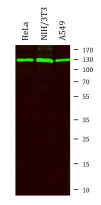ARG66797
anti-HIPK1 antibody
anti-HIPK1 antibody for Western blot and Human,Mouse
Overview
| Product Description | Rabbit Polyclonal antibody recognizes HIPK1 |
|---|---|
| Tested Reactivity | Hu, Ms |
| Predict Reactivity | Rat |
| Tested Application | WB |
| Host | Rabbit |
| Clonality | Polyclonal |
| Isotype | IgG |
| Target Name | HIPK1 |
| Antigen Species | Human |
| Immunogen | Synthetic peptide between aa. 290-370 of Human HIPK1. |
| Conjugation | Un-conjugated |
| Alternate Names | EC 2.7.11.1; Homeodomain-interacting protein kinase 1; Nuclear body-associated kinase 2; Myak; Nbak2 |
Application Instructions
| Predict Reactivity Note | The immunogen sequence homology to rat HIPK1 protein is 100%. | ||||
|---|---|---|---|---|---|
| Application Suggestion |
|
||||
| Application Note | * The dilutions indicate recommended starting dilutions and the optimal dilutions or concentrations should be determined by the scientist. | ||||
| Positive Control | HeLa, NIH/3T3 and A549 | ||||
| Observed Size | ~ 130 kDa |
Properties
| Form | Liquid |
|---|---|
| Purification | Affinity purification with immunogen. |
| Buffer | PBS, 0.02% Sodium azide and 50% Glycerol. |
| Preservative | 0.02% Sodium azide |
| Stabilizer | 50% Glycerol |
| Concentration | 1 mg/ml |
| Storage Instruction | For continuous use, store undiluted antibody at 2-8°C for up to a week. For long-term storage, aliquot and store at -20°C. Storage in frost free freezers is not recommended. Avoid repeated freeze/thaw cycles. Suggest spin the vial prior to opening. The antibody solution should be gently mixed before use. |
| Note | For laboratory research only, not for drug, diagnostic or other use. |
Bioinformation
| Database Links |
Swiss-port # O88904 Mouse Homeodomain-interacting protein kinase 1 Swiss-port # Q86Z02 Human Homeodomain-interacting protein kinase 1 |
|---|---|
| Gene Symbol | HIPK1 |
| Gene Full Name | homeodomain interacting protein kinase 1 |
| Background | The protein encoded by this gene belongs to the Ser/Thr family of protein kinases and HIPK subfamily. It phosphorylates homeodomain transcription factors and may also function as a co-repressor for homeodomain transcription factors. Alternative splicing results in four transcript variants encoding four distinct isoforms. [provided by RefSeq, Jul 2008] |
| Function | Serine/threonine-protein kinase involved in transcription regulation and TNF-mediated cellular apoptosis. Plays a role as a corepressor for homeodomain transcription factors. Phosphorylates DAXX and MYB. Phosphorylates DAXX in response to stress, and mediates its translocation from the nucleus to the cytoplasm. Inactivates MYB transcription factor activity by phosphorylation. Prevents MAP3K5-JNK activation in the absence of TNF. TNF triggers its translocation to the cytoplasm in response to stress stimuli, thus activating nuclear MAP3K5-JNK by derepression and promoting apoptosis. May be involved in anti-oxidative stress responses. Involved in the regulation of eye size, lens formation and retinal lamination during late embryogenesis. Promotes angiogenesis and to be involved in erythroid differentiation. May be involved in malignant squamous cell tumor formation. Phosphorylates PAGE4 at 'Thr-51' which is critical for the ability of PAGE4 to potentiate the transcriptional activator activity of JUN (PubMed:24559171). [UniProt] |
| Cellular Localization | Nucleus. Cytoplasm. Note=Predominantly nuclear. Translocates from nucleus to cytoplasm in response to stress stimuli via SENP1-mediated desumoylation. [UniProt] |
| Calculated MW | 131 kDa |
| PTM | Autophosphorylated. Phosphorylated and activated by JNK1. Degraded by PARK7 at the protein level. Sumoylated. When conjugated it is directed to nuclear speckles. SENP1-mediated desumoylation is mediated by TNF in response to stress stimuli, triggering transient translocation from nucleus to cytoplasm. [UniProt] |
Images (1) Click the Picture to Zoom In






